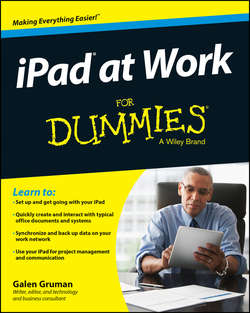Читать книгу iPad at Work For Dummies - Galen Gruman - Страница 6
На сайте Литреса книга снята с продажи.
Part I
Getting Started with iPad at Work
Chapter 2
Setting Up Your Own iPad for Work
Setting Up Apple ID and iCloud
ОглавлениеFor an iPad to access Apple’s services – iTunes, the App Store, iMessage, and FaceTime – you need an Apple ID. Chances are that you already have one: If you have an account at the iTunes Store, that’s your Apple ID. If you don’t have one, you’ll get the option of signing up for one when you first turn on your iPad and go through its Welcome screens. You can also sign up for an Apple ID via iTunes on your computer, by choosing Store⇒Create Apple ID and then following the prompts to create an Apple ID. (If you don’t see this option, choose Store⇒Sign Out first.) Or you can go to https://appleid.apple.com from any browser to set up your Apple ID.
Most people use their Apple ID to access both Apple’s online stores and Apple’s iCloud sync-and-storage service, given how convenient using one ID is. And you may not want to. If someone discovers your Apple ID, he or she can then use that ID to buy media from the iTunes Store, App Store, and so on, plus access any iCloud documents, email, browser bookmarks, and even passwords. That person could also sign in to iCloud.com and have your email redirected, so you wouldn’t get the notifications of his or her activities.
But don’t panic: Apple has several methods to reduce the risks of such account hijackings, as Chapter 3 describes. Still, using separate Apple IDs for your iTunes and iCloud accounts can be an easy way to add an extra margin of safety to your iPad’s services.
To use a different sign-in for iCloud than for iTunes, you need to create two Apple IDs (do so at https://appleid.apple.com) and then sign in to the iTunes Store and App Store via one ID and iCloud via another.
When you first set up a new iPad, you’re asked to sign in to the iTunes Store and into iCloud, so you can enter the two IDs and passwords then. Or you can skip those steps during setup and enter them in the Settings app later, as follows and as Figure 2-1 shows:
✔ In Settings, tap iCloud, enter your ID and password, and tap Sign In. You can also create a new Apple ID here.
✔ In Settings, tap iTunes & App Store, enter your ID and password, and tap Sign In. You can also create a new Apple ID here.
Figure 2-1: The iPad’s sign-in screens for iCloud (top) and iTunes (bottom).
If you are using a single Apple ID for both iTunes and iCloud and decide to create a separate ID for iCloud, you’ll have to sign out of your iCloud account on all devices that use it, and then sign in with the new ID. The documents and settings that had been stored in your old iCloud account will not transfer to the new one. For Safari bookmarks and passwords, that’s okay, because Safari will take whatever settings are stored locally on your various devices and send them to the new iCloud account. But your iCloud documents won’t do that, so be sure to first copy them to your computer or local storage on your iPad and then move them back to iCloud after you’ve switched accounts.
